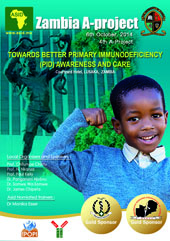By: Patricia Karani, HAEi Sub Saharan Representative, Nairobi, Kenya ()
Hereditary Angioedema (HAE) is a rare and disabling condition that runs in families and affects 1 in 10,000 to 50,000 individuals with a mortality rate of about 30%. HAE is a chronic inherited life-threatening condition that mostly manifests in massive swellings occurring spontaneously both externally on the muscle and subcutaneous tissues, and internally in the abdomen and throat. It may initially appear like an allergic or chronic spontaneous angioedema however with further investigations it is identified NOT TO BEmast cell or histamine- mediated allergic reaction and it DOES NOT respond to antihistamines, corticosteroids or epinephrine.
Early diagnosis of this condition saves lives. This depends on identifying the symptoms and signs and doing the correct laboratory investigations. HAE is a bradykinin mediated condition that stems from deficient and dysfunctional C1- inhibitor of the complement system. Peripheral swelling attacks appear on the face, lips, eyes, hands, feet and genitalia. These DO NOT present with urticaria or itching. The condition may also manifest in laryngeal swellings that could be life threatening. Abdominal swellings are especially very painful and debilitating and are accompanied by nausea and diarrhea. These may present as an acute abdomen which may lead to surgical intervention imposing even more hazards to the patient’s life.
According to World Allergy Organization the first line of management should be preventative medication.
Recommended prophylactic medications include androgens such as danazol and antifibrinolytics like tranexamic acid. These however are not recommended for on demand or emergency treatment as the drugs show no or only minimal effects when used after onset of swellings.
During the management of an attack C1-INH concentrate should be administered at the onset of the attack to experience a better and quicker resolution of the swelling.
Recommended effective emergency medications include C1 -INH concentrate and recombinant C1-INH as well as other therapies such as icatibant and ecallantide amongst others. In some cases where the modern medication is not available, solvent detergent treated plasma (SDP) or fresh frozen plasma (FFP) can be administered. It is also important to note that some of these medications are not recommended for pregnant/ lactating women as well as children.
Very few patients have been recorded in Africa in general and sub-Saharan Africa in particular. Knowing the clinical presentation of the disease is necessary as is the availability of laboratory diagnosis and treatment options. More awareness is required about the condition and better collaboration between practitioners, scientific and patient organizations is also needed to improve awareness and facilities.
HAEi is a non-profit organisation that brings together patients living with hereditary angioedema, as well as networking with physicians and caregivers with an aim to raise more awareness about the condition and thereby reduce the long lapse to diagnosis and ensure that patients have access to better management and effective treatments that reduce the debilitating effects of this rare yet life-threatening condition and consequently assist a patient realizes a more normal and productive life. HAEidelivers patient-membership organisations in more than 90 different countries globally and is hoping to reach as many patients as possible around the world.
Source:
The International WAO/ EAACI guideline for the management of hereditary angioedema -the 2017 revision and update.



























